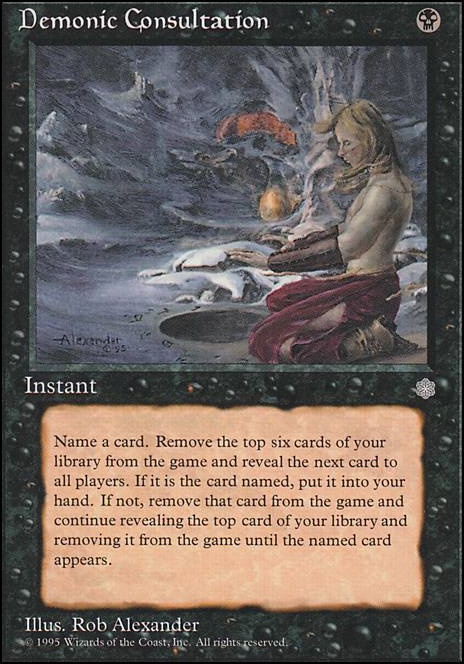
Consult Scepter Thrasios
Commander / EDH BUG (Sultai) Combo Competitive GWUB Infinite Combo Multiplayer
Instant (29)
- 1x Abrupt Decay
- 1x Ad Nauseam
- 1x Assassin's Trophy
- 1x Brainstorm
- 1x Chain of Vapor
- 1x Counterspell
- 1x Cyclonic Rift
- 1x Dark Ritual
- 1x Delay
- 1x Demonic Consultation
- 1x Dispel
- 1x Dovin's Veto
- 1x Dramatic Reversal
- 1x Drown in the Loch
- 1x Enlightened Tutor
- 1x Fierce Guardianship
- 1x Flusterstorm
- 1x Force of Will
- 1x Lim-Dul's Vault
- 1x Mana Drain
- 1x Mental Misstep
- 1x Mystical Tutor
- 1x Noxious Revival
- 1x Pact of Negation
- 1x Silence
- 1x Swan Song
- 1x Tainted Pact
- 1x Vampiric Tutor
- 1x Veil of Summer
Artifact (11)
Land (28)
- 1x Ancient Tomb
- 1x Bayou
- 1x Bloodstained Mire
- 1x Breeding Pool
- 1x City of Brass
- 1x Command Tower
- 1x Exotic Orchard
- 1x Flooded Strand
- 1x Forbidden Orchard
- 1x Gemstone Caverns
- 1x Mana Confluence
- 1x Marsh Flats
- 1x Misty Rainforest
- 1x Morphic Pool
- 1x Nurturing Peatland
- 1x Polluted Delta
- 1x Savannah
- 1x Scalding Tarn
- 1x Snow-Covered Island
- 1x Tarnished Citadel
- 1x Tropical Island
- 1x Tundra
- 1x Underground Sea
- 1x Verdant Catacombs
- 1x Waterlogged Grove
- 1x Watery Grave
- 1x Windswept Heath
- 1x Wooded Foothills
Sorcery (10)
- 1x Demonic Tutor
- 1x Gitaxian Probe
- 1x Imperial Seal
- 1x Neoform
- 1x Ponder
- 1x Preordain
- 1x Timetwister
- 1x Toxic Deluge
- 1x Windfall
- 1x Yawgmoth's Will
Planeswalker (1)
Commanders (2)
Creature (12)
- 1x Arbor Elf
- 1x Avacyn's Pilgrim
- 1x Birds of Paradise
- 1x Bloom Tender
- 1x Dark Confidant
- 1x Deathrite Shaman
- 1x Elves of Deep Shadow
- 1x Gilded Drake
- 1x Noble Hierarch
- 1x Notion Thief
- 1x Priest of Titania
- 1x Thassa's Oracle
Enchantment (7)
Maybeboard
Instant (15)
Creature (10)
- 1x Aven Mindcensor
- 1x Boreal Druid
- 1x Containment Priest
- 1x Elvish Mystic
- 1x Faeburrow Elder
- 1x Fyndhorn Elves
- 1x Laboratory Maniac
- 1x Llanowar Elves
- 1x Seedborn Muse
- 1x Spellseeker
Sorcery (1)
Planeswalker (1)
Land (1)
Artifact (8)
- 1x Azorius Signet
- 1x Dimir Signet
- 1x Mox Amber
- 1x Mox Opal
- 1x Simic Signet
- 1x Talisman of Curiosity
- 1x Talisman of Dominance
- 1x Talisman of Progress
Enchantment (4)
Suggestions
Updates Add
Comments View Archive
Attention! Complete Comment Tutorial! This annoying message will go away once you do!
Important! Formatting tips — Comment Tutorial — markdown syntax
Please login to comment
Revision 18 See all
(4 years ago)
| +1 | Fierce Guardianship | main |
| -1 | Negate | main |
| -1 | Scroll Rack | maybe |
| -1 | Voltaic Key | maybe |
| Top Ranked |
|
| Date added | 6 years |
| Last updated | 3 years |
| Exclude colors | R |
| Splash colors | W |
| Legality | This deck is Commander / EDH legal. |
| Rarity (main - side) | 13 - 0 Mythic Rares 57 - 0 Rares 13 - 0 Uncommons 16 - 0 Commons |
| Cards | 100 |
| Avg. CMC | 1.74 |
| Tokens | Bird 2/2 U, Spirit 1/1 C, Treasure |
| Folders | cEDH_Resources, shaper is the best, EDH, CEDH, Competitive EDH, PST, Interesting Commander Decks, Thrasios Builds, cEDH, cedh |
| Votes | |
| Ignored suggestions | |
| Shared with | |
| Views |

